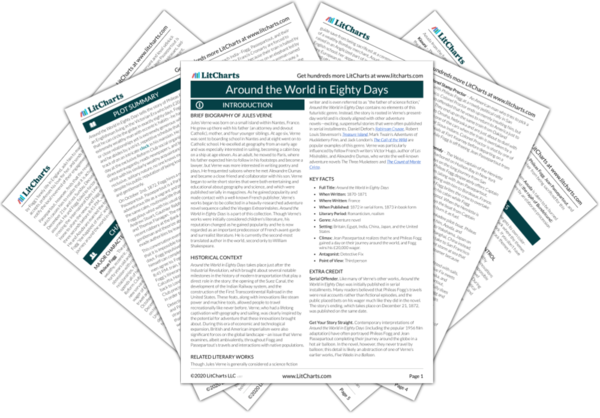Welcome to the LitCharts study guide on Jules Verne's Around the World in Eighty Days. Created by the original team behind SparkNotes, LitCharts are the world's best literature guides.
Around the World in Eighty Days: Introduction
Around the World in Eighty Days: Plot Summary
Around the World in Eighty Days: Detailed Summary & Analysis
Around the World in Eighty Days: Themes
Around the World in Eighty Days: Quotes
Around the World in Eighty Days: Characters
Around the World in Eighty Days: Terms
Around the World in Eighty Days: Symbols
Around the World in Eighty Days: Theme Wheel
Brief Biography of Jules Verne

Historical Context of Around the World in Eighty Days
Other Books Related to Around the World in Eighty Days
- Full Title: Around the World in Eighty Days
- When Written: 1870-1871
- Where Written: France
- When Published: 1872 in serial form, 1873 in book form
- Literary Period: Romanticism, realism
- Genre: Adventure novel
- Setting: Britain, Egypt, India, China, Japan, and the United States
- Climax: Jean Passepartout realizes that he and Phileas Fogg gained a day on their journey around the world, and Fogg wins his £20,000 wager.
- Antagonist: Detective Fix
- Point of View: Third person
Extra Credit for Around the World in Eighty Days
Serial Offender. Like many of Verne’s other works, Around the World in Eighty Days was initially published in serial installments. Many readers believed that Phileas Fogg’s travels were real accounts rather than fictional episodes, and the public placed bets on his wager much like they did in the novel. The story’s ending, which takes place on December 21, 1872, was published on the same date.
Get Your Story Straight. Contemporary interpretations of Around the World in Eighty Days (including the popular 1956 film adaptation) have often portrayed Phileas Fogg and Jean Passepartout completing their journey around the globe in a hot air balloon. In the novel, however, they never travel by balloon; this detail is likely an abstraction of one of Verne’s earlier works, Five Weeks in a Balloon.












